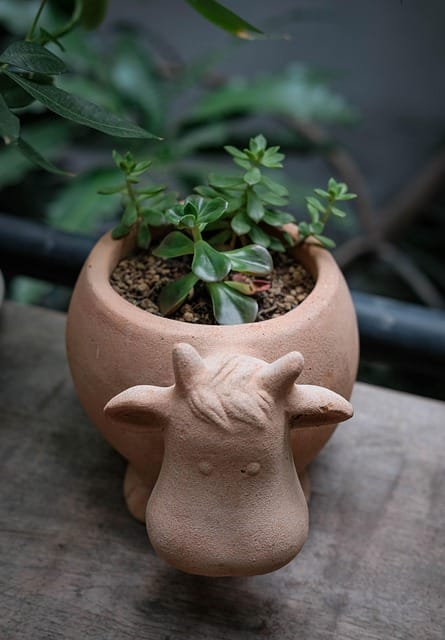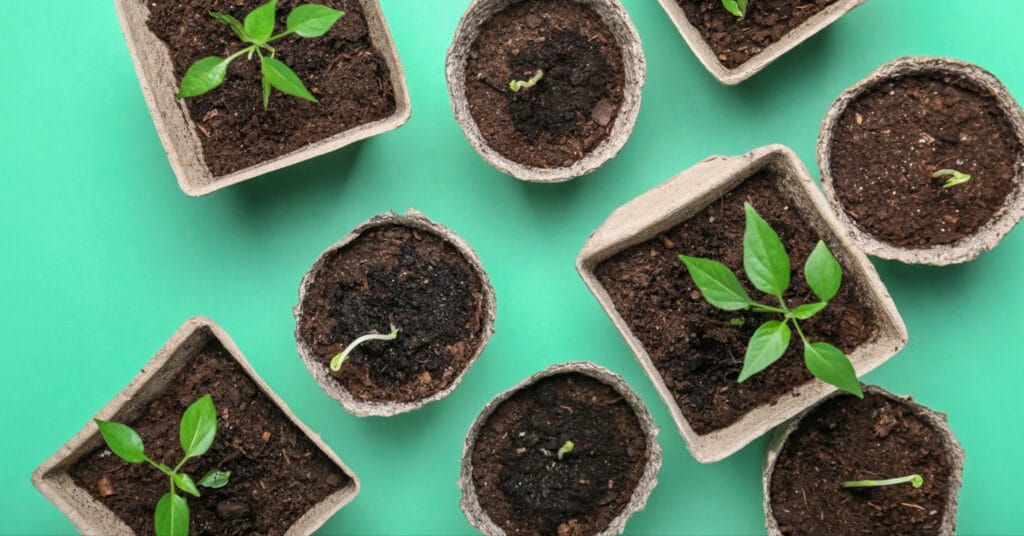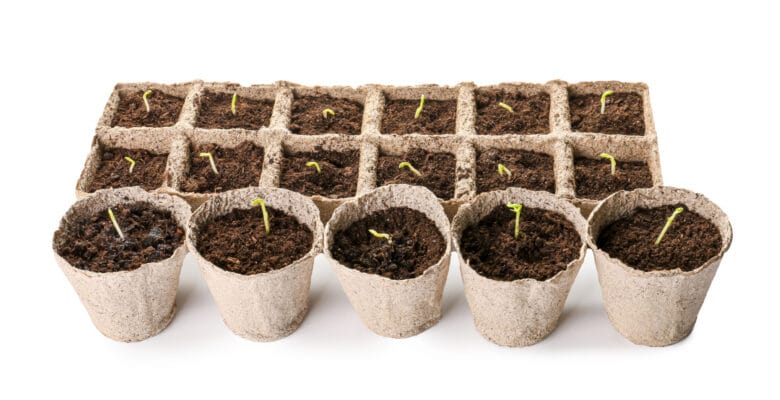Disclosure: This post may contain affiliate links, meaning we get a commission if you decide to make a purchase through our links, at no cost to you. See our full disclosure here.
Picture this: a bright-eyed, bushy-tailed gardener (yours indeed) eagerly sowing seeds in those ubiquitous peat pots, dreaming of a bountiful harvest. Fast forward a few months, and the seedlings are looking a bit… sad. Stunted, I might even say. “What’s going on?” I wondered, scratching my head. “I followed the instructions to a T!” Little did I know, those innocent-looking peat pots were behind my gardening woes.
Biodegradable plant pots, like those made of peat, have long been touted as the eco-friendly solution for seed starting. They’re made from natural materials, so you can pop the whole thing into the ground when it’s time to transplant–no plastic waste to worry about! Plus, they’re supposed to help reduce transplant shock, allowing your seedlings to settle into their new home with minimal fuss. Sounds like a win-win, right?
Well, not always. I discovered firsthand that peat pots can sometimes do more harm than good. Despite their eco-friendly appeal, they often hinder plant growth because of a small problem called root binding. In this post, I’ll share my experience with peat pots gone wrong, explain why they can be problematic, and offer some alternative solutions for successful seed starting. So, grab a cup of coffee, settle in, and dig into the world of biodegradable pots–and why peat pots might not always be the best choice for your garden.
Biodegradable Plant Pots: The Eco Promise
Peat pots, those humble brown cylinders, are made from decomposed sphagnum moss, a material known for its moisture-retentive properties. The idea behind them is neat: you start your seeds in these biodegradable pots, and when the seedlings are big enough, you plant the whole shebang directly into the ground. No more carefully prying seedlings out of plastic containers, potentially damaging those delicate roots!
I’ll admit the benefits are enticing. Peat pots are biodegradable, so they’re a more eco-friendly option than plastic. They’re also supposed to reduce transplant shock, as the seedlings don’t have to adjust to a new environment when planted. And because peat moss is naturally acidic, it can benefit acid-loving plants like blueberries and azaleas.
But here’s the rub: peat pots can be finicky. When I was running my garden center, we experimented to compare the performance of different types of pots for seed starting. We used peat pots, of course, along with those standard plastic pots and some cow pots (which are made from, you guessed it, cow manure!). We planted the same type of seedlings in each pot, gave them the same care, and then transplanted them into the ground simultaneously.

The results were surprising, to say the least. While the seedlings in the plastic and cow pots thrived, the ones in the peat pots seemed to lag. They were smaller, less vigorous, and didn’t seem as happy overall. We investigated further and dug up a few plants at the season’s end. Lo-and-behold, we found that the roots of many of the peat pot seedlings were trapped inside the pots!
The peat pots, which were supposed to break down easily in the soil, hadn’t decomposed quickly enough. As a result, the roots had become entangled within the pot walls, unable to spread out and access the nutrients they needed. This phenomenon, known as root binding, can severely stunt plant growth and even lead to plant death.
A New Problem
This created an additional problem for us. You see, at the garden center, we had several hundred peat pots planned for seedlings. This was, of course, the buyer’s fault, who had gotten carried away at a buying show. Unfortunately, that buyer was me ☹
We were afraid to use them. Then we had an idea. What if we help the plants escape?
Our Solution
So, we drilled a bunch of holes in the pots before we used them. I guess the drill bit we used was probably ⅛ an inch. The process wasn’t scientific, so I can’t tell you how many holes we drilled. We just drilled a bunch. Then we started our seeds in the pots like normal. The holes caused the pots to dry out faster, but we had no problem keeping our moisture good.
Of course, plant geeks get very attached to their seedlings, so we were still worried about transplanting. So, we took one more step. Before planting, we scratched up the outside of the pots with a knife. This helped break through the outer shell created in the manufacturing process.
Our Results
Our plants thrived. They were comparable to the cow pots, and the ones grown in plastic trays were removed and planted directly into the soil. Of course, we dug up some plants to check on those peat pots. We found that many more roots escaped early through the holes. Also, the pot itself had broken down much more thoroughly. We still found remnants (normally a ring at the top of the original pot), but much of the pot had dissolved, and the roots found their nutrients.

Tips for Using Biodegradable Plant Pots
If you’re starting seedlings in biodegradable pots, there are a few things you can do to ensure your plants thrive:
- Decide on the correct pot for your preferences. Cow pots are a good choice for starting seeds because they are sturdy and retain moisture. You can also make your own pots from newspaper or cardboard. If using peat, add some additional holes to the sides of the pots.
- Plant the pot properly. When you’re ready to transplant your seedlings, it’s essential to plant the pot correctly. Dig a hole deep enough to bury the entire pot, then tear or score the pot before planting. This will help the roots escape the pot and grow into the surrounding soil.
- Soak the pot thoroughly and drench it in water before planting. This will help the pot break down quickly in the soil and prevent the roots from becoming rootbound.
- Monitor plant growth and address potential issues. After you’ve transplanted your seedlings, monitor them. If you see any signs of stress, such as wilting or yellowing leaves, address the issue immediately. You may need to water more often, provide additional fertilizer, or even repot the seedlings into a larger container.
So, there you have it. The peat pot problem is real, and it’s something that every gardener should know. Peat pots may be okay for some plants, but they can be a significant obstacle to healthy growth for others. When you sow seeds in biodegradable plant pots, be sure to do your research and choose the right pot for your needs.
Several options are available if you’re looking for an alternative to peat pots. Cow pots are excellent for starting seeds; they are strong and effectively keep moisture.
Plastic Trays? Are they bad?
I use plastic trays to start seeds for plants that stay small. I am not concerned about the biodegradability or eco-consciousness of the plastic because I usually get 5 or 6 years out of it. Compared to buying something new each year that must be manufactured and shipped halfway around the world, I suspect my trusty, re-used plastic trays have the same or less impact on the environment. So use what you are most comfortable with.
Now it’s your turn. Have you had any experience with biodegradable pots, good or bad? Share your thoughts in the comments below. And if you have questions, be sure to ask. I’m always happy to help fellow gardeners troubleshoot their problems and grow healthy, thriving plants.
Disclaimer: This post is for informational purposes only and should not be construed as health, wellness or nutrition advice. Please see our full disclaimers here.


Leave a Reply